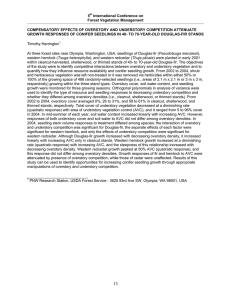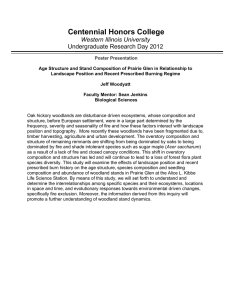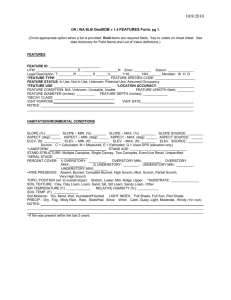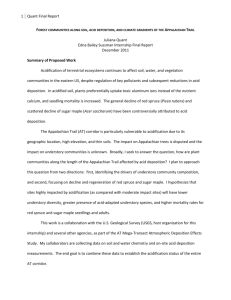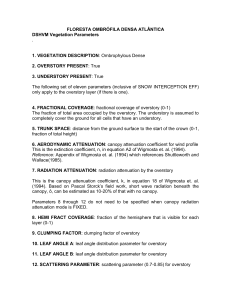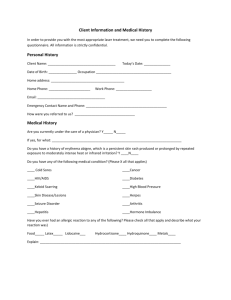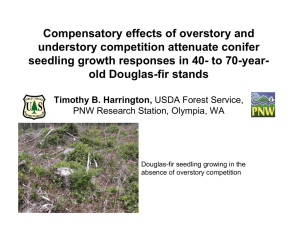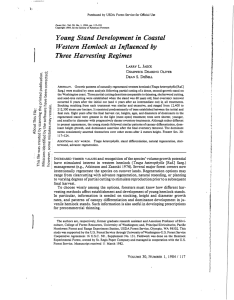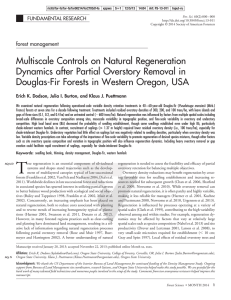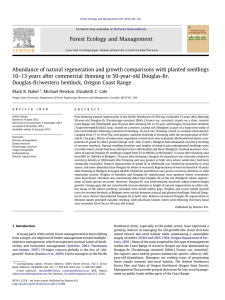Document 11863682
advertisement
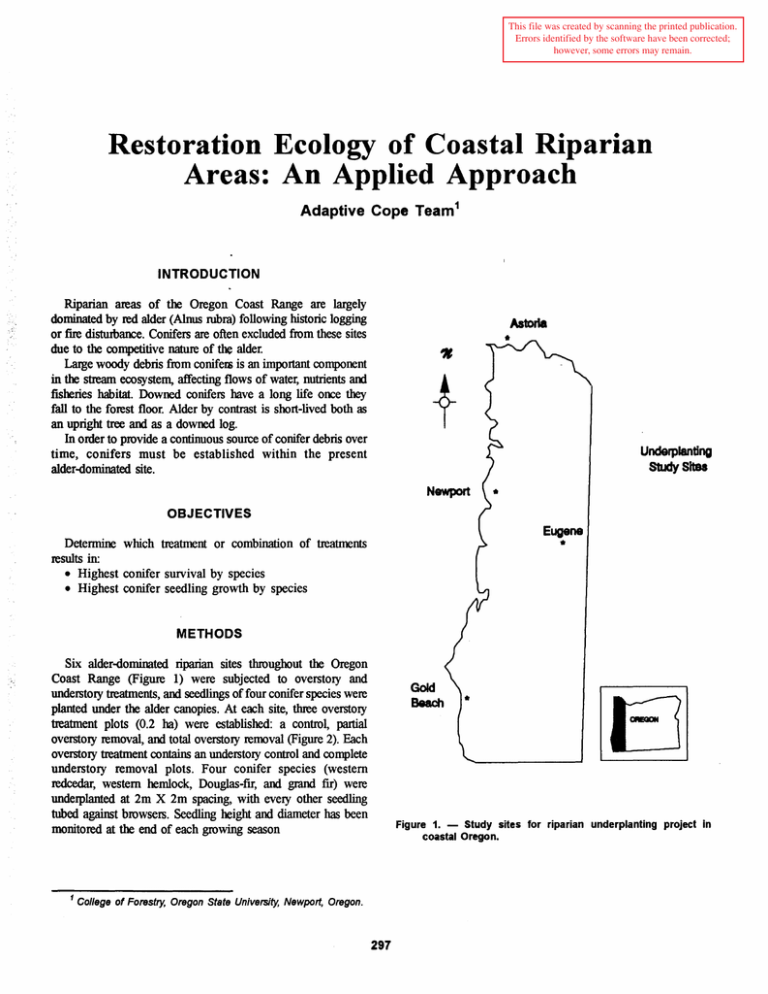
This file was created by scanning the printed publication. Errors identified by the software have been corrected; however, some errors may remain. Restoration Ecology of Coastal Riparian Areas: An Applied Approach Adaptive Cope Team 1 INTRODUCTION Riparian areas of the Oregon Coast Range are largely dominated by red alder (Alnus rubra) following historic logging or fire distmbance. Conifers are often excluded from these sites due to the competitive nature of the alder. Latge woody debris from conifeo; is an important component in the stream ecosystem, affecting flows of water, nutrients and fisheries habitat. Downed conifers have a long life once they fall to the forest floor. Alder by contrast is short-lived both as an upright tree and as a downed log. In order to provide a continuous source of conifer debris over time, conifers must be established within the present alder-dominated site. . Astoria t Underplanting Study Sltas Newport OBJECTIVES Eugene Determine which treatment or combination of treatments results in: • Highest conifer swvival by species • Highest conifer seedling growth by species * METHODS Six alder-dominated riparian sites throughout the Oregon Coast Range (Figure 1) were subjected to overstory and understory treatments, and seedlings of four conifer species were planted under the alder canopies. At each site, three overstory treatment plots (0.2 ha) were established: a control, partial overstory removal, and total overstory removal (Figure 2). Each overstory treatment contains an understory control and complete understory removal plots. Four conifer species (western redcedar, western hemlock, Douglas-fir, and grand fir) were underplanted at 2m X 2m spacing, with every other seedling tubed against browsers. Seedling height and diameter has been monitored at the end of each growing season 1 Gold Beach Figure 1. - Study sites for riparian underplanting project in coastal Oregon. College of Forestry, Oregon State University, Newport, Oregon. 297 treatments than in the control, but height growth in the total and partial overstory treatments were not significantly different from each other. Mean height growth of western hemlock was significantly (p<.05) higher than all other species. Douglas-fir height growth was not different than grand fIT, but was significantly (p<.05) greater than western redcedar. BLOCK (SITE) Overatory Treatment-Control SUMMARY Treatment Treatment COntrol Total Removal OF OF WH WAC Though the results of this experiment are preliminaIy, some early trends are i~enti:fied. With partial or no overstory removal, understory manipulation is important to the swvival of all species with the exception of western redcedar. With total overstory removal, understory manipulation appears important to Douglas-fIT swvival in particular. Total or partial overstory manipulation resulted in greater seedling height growth. Western hemlock outperfonned all other species over all treatments f9r height growth. Tubed seedlings grew taller than non-tubed seedlings. OF OF WH WRC Ovarstary Treetmant·PartIaI Removal UnderItory Understory Treatment Treatment Control Total Removal DF GF WH WRC UndemoIy understory Traetmant Traatment Control Total Removal OF GF WH WRC CONCLUSIONS OF GF WH WRC This study is beginning to answer questions concerning the establishment of conifer seedlings in riparian areas when light is the limiting resource. The results presented here represent initial response to treatments in the flfSt two years. The study will be monitored for a total of six years. This applied research project compliments many fundamental riparian research projects administered by the COPE program, including studies of vegetation dynamics, hydrology, and fisheries and wildlife research. OF GF WH WRC This research is cooperatively funded by: Figure 2. - Experimental design for underplanting study, showing the overstory, understory. and species treatments at each site (block). Underplanted conifers were DF=Douglas fir, GF=grand fir. WH=western hemlock. WRC=western redcedar. RESULTS • Oregon State University • Coastal Oregon Productivity Enhancement • (COPE) Program • Other State and Federal Agencies • The Forest Industry • County Governments • Oregon Small Woodlands Association Swvival by species over all sites and treatments was quite variable, but some overall trends are apparent after two years (Figure 3). Western redcedar had high swvival on most sites relative to the other species, however some decline in swvival was seen by the end of the second year. With partial or no overstory removal, understory manipulation appears to be a key factor in SUIVival of all species except western redcedar. Height growth increment for seedlings was significantly affected by the overstory treatment (p<.Ol), species (p<.OOOl), and tubing effects (p<.OOOl). Mean height growth was significantly (p<.05) higher in both the total and partial overstory 298 Percent Survival 100~----------------------------------------------------- 804-------+-~------------r-+-- 80 40 20 o Douglas-fir w. hemlock grand fir w. redcedar Traa1m8ntS • § Over none Under none Over part Under total HIII1 Over none Under total mB Over total Under none I§§I Over part Under none ~ Over total Under total Figure 3. - Survival of seedlings at the end of two years in all combinations of treatments. Treatments legend describes the combination of treatments as Over none Under none = Overstory removal none, Understory removal none, etc. 299
